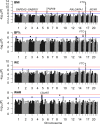Genome-wide association study identifies genetic risk loci for adiposity in a Taiwanese population
- PMID: 35051171
- PMCID: PMC8853642
- DOI: 10.1371/journal.pgen.1009952
Genome-wide association study identifies genetic risk loci for adiposity in a Taiwanese population
Abstract
Overweight and obese are risk factors for various diseases. In Taiwan, the combined prevalence of overweight and obesity has increased dramatically. Here, we conducted a genome-wide association study (GWAS) on four adiposity traits, including body-mass index (BMI), body fat percentage (BF%), waist circumference (WC), and waist-hip ratio (WHR), using the data for more than 21,000 subjects in Taiwan Biobank. Associations were evaluated between 6,546,460 single-nucleotide polymorphisms (SNPs) and adiposity traits, yielding 13 genome-wide significant (GWS) adiposity-associated trait-loci pairs. A known gene, FTO, as well as two BF%-associated loci (GNPDA2-GABRG1 [4p12] and RNU6-2-PIAS1 [15q23]) were identified as pleiotropic effects. Moreover, RALGAPA1 was found as a specific genetic predisposing factor to high BMI in a Taiwanese population. Compared to other populations, a slightly lower heritability of the four adiposity traits was found in our cohort. Surprisingly, we uncovered the importance of neural pathways that might influence BF%, WC and WHR in the Taiwanese (East Asian) population. Additionally, a moderate genetic correlation between the WHR and BMI (γg = 0.52; p = 2.37×10-9) was detected, suggesting different genetic determinants exist for abdominal adiposity and overall adiposity. In conclusion, the obesity-related genetic loci identified here provide new insights into the genetic underpinnings of adiposity in the Taiwanese population.
Conflict of interest statement
The authors have declared that no competing interests exist.
Figures



Similar articles
-
Interactions between genetic variants associated with adiposity traits and soft drinks in relation to longitudinal changes in body weight and waist circumference.Am J Clin Nutr. 2016 Sep;104(3):816-26. doi: 10.3945/ajcn.115.122820. Epub 2016 Jul 27. Am J Clin Nutr. 2016. PMID: 27465380
-
Generalization and fine mapping of European ancestry-based central adiposity variants in African ancestry populations.Int J Obes (Lond). 2017 Feb;41(2):324-331. doi: 10.1038/ijo.2016.207. Epub 2016 Nov 21. Int J Obes (Lond). 2017. PMID: 27867202 Free PMC article.
-
Genome-wide association of body fat distribution in African ancestry populations suggests new loci.PLoS Genet. 2013;9(8):e1003681. doi: 10.1371/journal.pgen.1003681. Epub 2013 Aug 15. PLoS Genet. 2013. PMID: 23966867 Free PMC article.
-
The genetics of adiposity.Curr Opin Genet Dev. 2018 Jun;50:86-95. doi: 10.1016/j.gde.2018.02.009. Epub 2018 Mar 9. Curr Opin Genet Dev. 2018. PMID: 29529423 Free PMC article. Review.
-
Comprehensive identification of pleiotropic loci for body fat distribution using the NHGRI-EBI Catalog of published genome-wide association studies.Obes Rev. 2019 Mar;20(3):385-406. doi: 10.1111/obr.12806. Epub 2018 Nov 22. Obes Rev. 2019. PMID: 30565845 Review.
Cited by
-
Genetic Overlap Between Obstructive Sleep Apnea and Ischemic Stroke: A Large-Scale Genome-Wide Cross-Trait Analysis.Nat Sci Sleep. 2025 Mar 8;17:413-424. doi: 10.2147/NSS.S495422. eCollection 2025. Nat Sci Sleep. 2025. PMID: 40078878 Free PMC article.
-
Father's adolescent body silhouette is associated with offspring asthma, lung function and BMI through DNA methylation.Commun Biol. 2025 May 24;8(1):796. doi: 10.1038/s42003-025-08121-9. Commun Biol. 2025. PMID: 40410506 Free PMC article.
-
Genetic variant panel allows predicting both obesity risk, and efficacy of procedures and diet in weight loss.Front Nutr. 2023 Nov 16;10:1274662. doi: 10.3389/fnut.2023.1274662. eCollection 2023. Front Nutr. 2023. PMID: 38035352 Free PMC article.
-
Identification of a new genetic locus associated with atrial fibrillation in the Taiwanese population by genome-wide and transcriptome-wide association studies.Europace. 2025 Mar 28;27(4):euaf042. doi: 10.1093/europace/euaf042. Europace. 2025. PMID: 40036802 Free PMC article.
-
A Genome-Wide Association Study of Metabolic Syndrome in the Taiwanese Population.Nutrients. 2023 Dec 25;16(1):77. doi: 10.3390/nu16010077. Nutrients. 2023. PMID: 38201907 Free PMC article.
References
-
- Abarca-Gómez L, Abdeen ZA, Hamid ZA, Abu-Rmeileh NM, Acosta-Cazares B, Acuin C, et al.. Worldwide trends in body-mass index, underweight, overweight, and obesity from 1975 to 2016: a pooled analysis of 2416 population-based measurement studies in 128·9 million children, adolescents, and adults. The Lancet. 2017;390(10113):2627–42. doi: 10.1016/s0140-6736(17)32129-3 - DOI - PMC - PubMed
-
- Chang HC, Yang HC, Chang HY, Yeh CJ, Chen HH, Huang KC, et al.. Morbid obesity in Taiwan: Prevalence, trends, associated social demographics, and lifestyle factors. PLoS One. 2017;12(2):e0169577. Epub 2017/02/06. doi: 10.1371/journal.pone.0169577 ; PubMed Central PMCID: PMC5289420. - DOI - PMC - PubMed
-
- Czernichow S, Kengne AP, Stamatakis E, Hamer M, Batty GD. Body mass index, waist circumference and waist-hip ratio: which is the better discriminator of cardiovascular disease mortality risk?: evidence from an individual-participant meta-analysis of 82 864 participants from nine cohort studies. Obes Rev. 2011;12(9):680–7. Epub 2011/04/28. doi: 10.1111/j.1467-789X.2011.00879.x ; PubMed Central PMCID: PMC4170776. - DOI - PMC - PubMed
Publication types
MeSH terms
Substances
LinkOut - more resources
Full Text Sources
Miscellaneous

